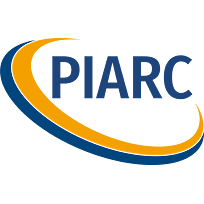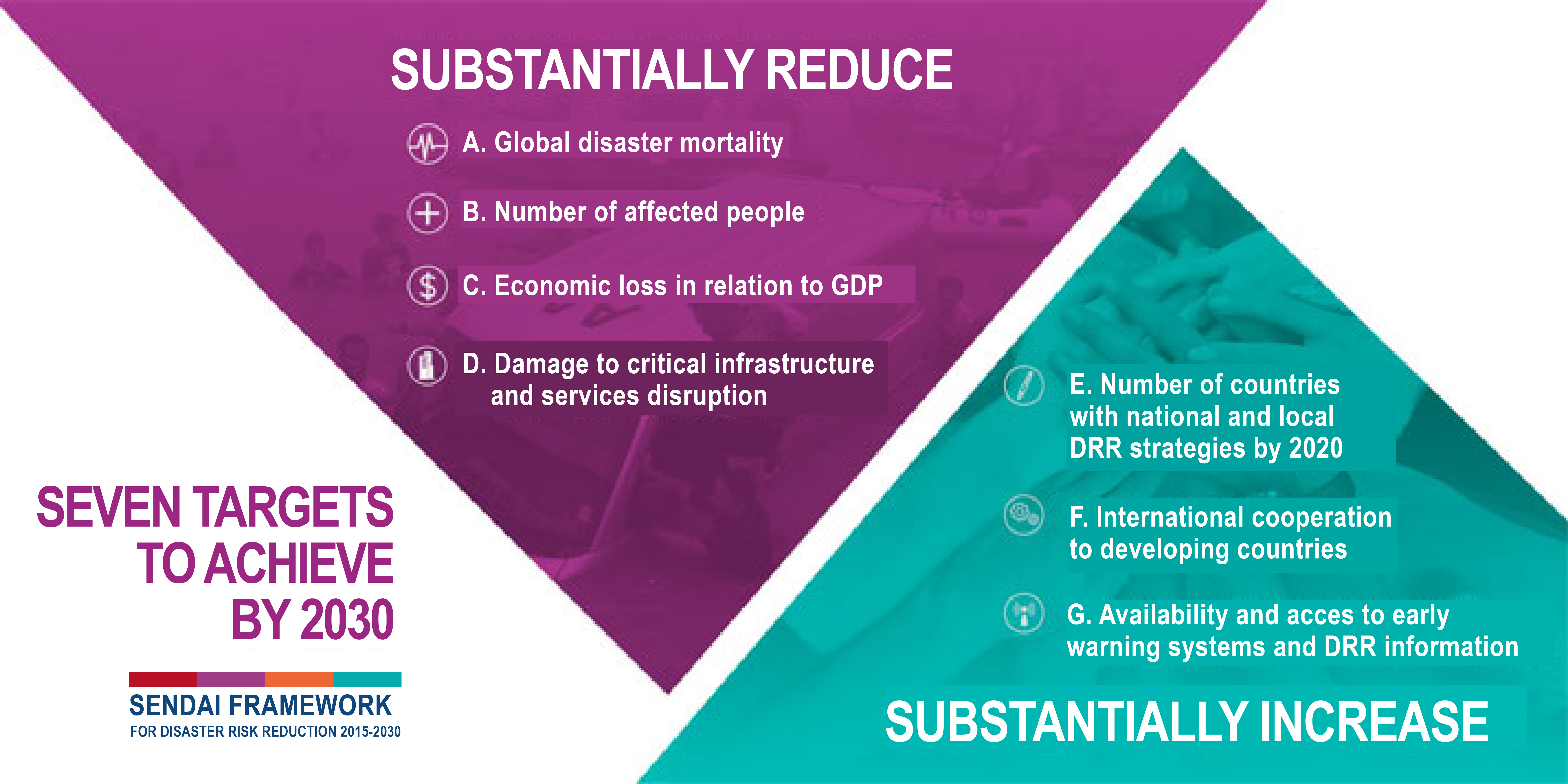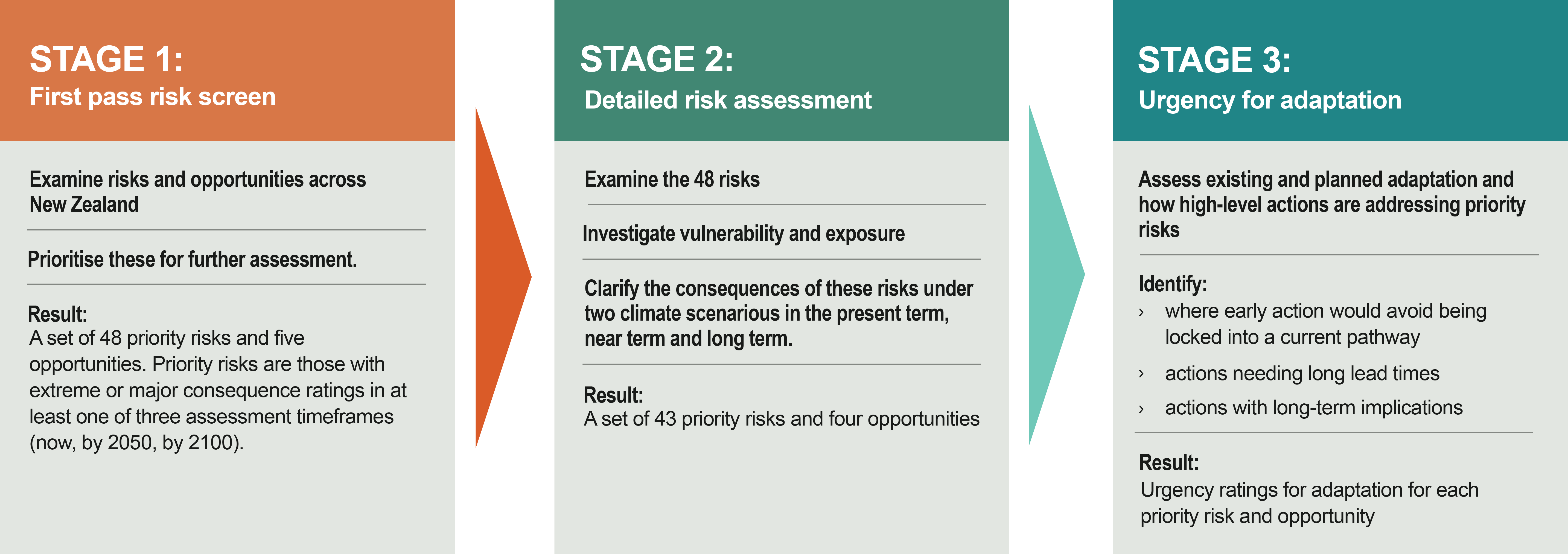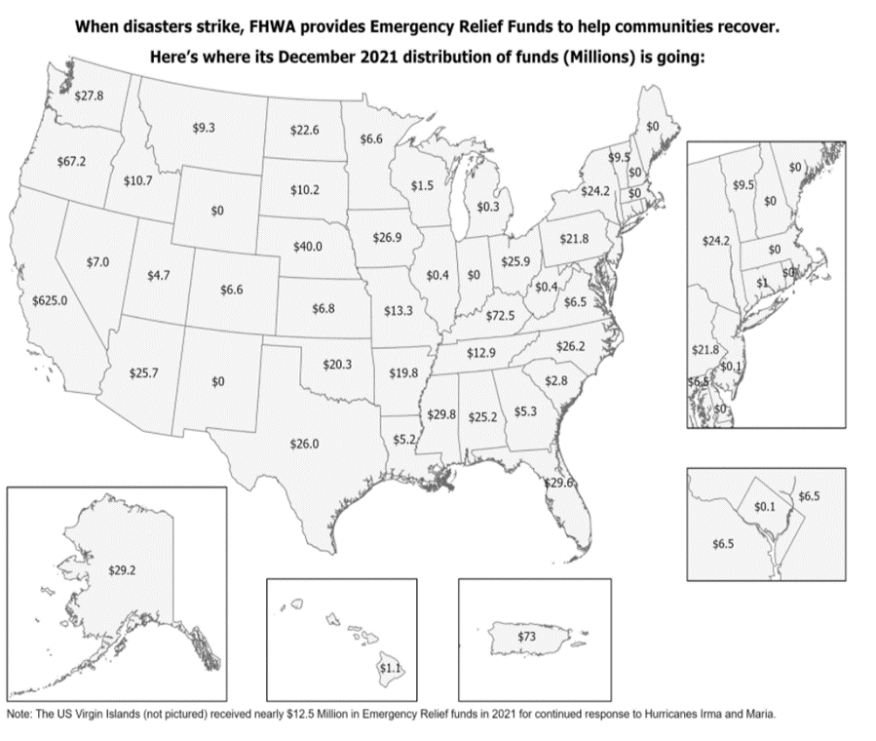

United Nations Office for Disaster Risk Reduction (formerly UNISDR) is the United Nations focal point for disaster risk reduction, overseeing the implementation of the Sendai Framework for Disaster Risk Reduction 2015-2030, supporting countries in its implementation, monitoring and sharing what works in reducing existing risk and preventing the creation of new risk. 1

Figure 1.1.2-1 Sendai Framework Targets
The Sendai Framework for Disaster Risk Reduction was adopted at the Third UN World Conference on Disaster Risk Reduction in Sendai, Japan, on March 18, 2015. Seven global targets and four priorities of action are to be achieved between 2015 and 2030. The UN creates a Global Assessment Report (GAR) every two years to chart the global progress of the Sendai Framework.
“The Sendai Framework is the roadmap for how we make our communities safer and more resilient, it works hand in hand with the other 2030 Agenda agreements, including The Paris Agreement on Climate Change, The Addis Ababa Action Agenda on Financing for Development, the New Urban Agenda, and ultimately the Sustainable Development Goals.” 2

2. Number of people affected by disasters
3. Economic loss in relation to global Gross Domestic Product (GDP)
4. Damage to critical infrastructure and disruption of basic services

1. The number of countries with disaster risk reduction strategies
2. International cooperation to developing countries
3. Availability to multi-hazard early warning systems and disaster risk information and assessments
Priority 1 of the Sendai Framework states that “Policies and practices for disaster risk management should be based on an understanding of disaster risk in all its dimensions of vulnerability, capacity, exposure of persons and assets, hazard characteristics and the environment. Such knowledge can be leveraged for the purpose of pre-disaster risk assessment, for prevention and mitigation and for the development and implementation of appropriate preparedness and effective response to disasters.” 1
Risk assessment is an important part of this priority. “New Zealand has developed their first national climate change risk assessment, helping the Government identify where it needs to prioritize action. The assessment:

Figure 1.1.2.1 New Zealand Risk Assessment Stages
Priority 2 of the Sendai Framework states that “Disaster risk governance at the national, regional and global levels is of great importance for an effective and efficient management of disaster risk. Clear vision, plans, competence, guidance, and coordination within and across sectors, as well as participation of relevant stakeholders, are needed. Strengthening disaster risk governance for prevention, mitigation, preparedness, response, recovery, and rehabilitation is therefore necessary and fosters collaboration and partnership across mechanisms and institutions for the implementation of instruments relevant to disaster risk reduction and sustainable development.” 1
Key stakeholder coordination within and across sectors can be facilitated using resource contact sheets containing the agency name, contact name, position, and contact information.
Here is a sample template from the American Association of State Highway Transportation Officials (AASHTO) publication, Managing Catastrophic Transportation Emergencies: A Guide for Transportation Executives. 2
Organization | ||||
|---|---|---|---|---|
Agency/Sub-Organization | POC Name | Position Title | Telephone | |
Internal |
|
|
|
|
Homeland Security Coordinator |
|
|
|
|
Emergency Management Coordinator |
|
|
|
|
Emergency Support Function ESF-1 Coordinator |
|
|
|
|
District Contacts |
|
|
|
|
District A |
|
|
|
|
Federal Government |
|
| ||
U.S. Department of Transportation (U.S. DOT) |
|
|
|
|
Federal Aviation Administration (FAA) |
|
|
|
|
Federal Highway Administration (FHWA) | ||||
Local FHWA Contact |
|
|
|
|
Interstate |
|
|
|
|
State A |
|
|
|
|
|
|
|
| |
Other organization as appropriate |
|
|
|
|
|
|
|
|
|
Local |
|
|
|
|
County/Parish A |
|
|
|
|
Sheriff's Office |
|
|
|
|
Fire Department |
|
|
|
|
Other Partners |
|
|
|
|
Priority 3 of the Sendai Framework states that “Public and private investment in disaster risk prevention and reduction through structural and non-structural measures are essential to enhance the economic, social, health and cultural resilience of persons, communities, countries and their assets, as well as the environment. These can be drivers of innovation, growth, and job creation. Such measures are cost-effective and instrumental to save lives, prevent and reduce losses and ensure effective recovery and rehabilitation.” 1
Disaster financial planning is essential for returning, or bouncing back, from a disaster as quickly as possible. In the United States, “Congress authorized in Title 23, United States Code, Section 125, a special program from the Highway Trust Fund for the repair or reconstruction of Federal-aid highways and roads on Federal lands which have suffered serious damage as a result of (1) natural disasters or (2) catastrophic failures from an external cause. This program, commonly referred to as the emergency relief or ER program, supplements the commitment of resources by States, their political subdivisions, or other Federal agencies to help pay for unusually heavy expenses resulting from extraordinary conditions.” 2 , 3

Figure 1.1.2.3 Map of Allocation of Emergency Relief (ER) for Federal-aid Highways (ERFA) Funds and Allotment of Emergency Relief for Federally owned Roads (ERFO) Funds, Fiscal Year (FY) 2022
Priority 4 of the Sendai Framework states that: “The steady growth of disaster risk, including the increase of people and assets exposure, combined with the lessons learned from past disasters, indicates the need to further strengthen disaster preparedness for response, take action in anticipation of events, integrate disaster risk reduction in response preparedness and ensure that capacities are in place for effective response and recovery at all levels. Empowering women and persons with disabilities to publicly lead and promote gender equitable and universally accessible response, recovery, rehabilitation, and reconstruction approaches is key. Disasters have demonstrated that the recovery, rehabilitation, and reconstruction phase, which needs to be prepared ahead of a disaster, is a critical opportunity to “Build Back Better”, including through integrating disaster risk reduction into development measures, making nations and communities resilient to disasters.” 1
Lessons learned from past disasters are a key feature of building back better. In the United States, the Federal Highway Administration (FHWA) will reimburse States through it’s Emergency Relief (ER) program for Betterments.
“Betterments are added protective features, such as rebuilding of roadways at a higher elevation or lengthening of bridges, or changes which modify the function or character of a highway facility, from what existed prior to the disaster or catastrophic failure, such as additional lanes or added access control. Betterments must be clearly economically justified to receive ER funding and almost always have a higher initial cost, so the justification must be based on sufficiently reducing future ER eligible damage.” 2 Economical justification depends on the reduction of future damage.
“The following items would likely increase the resiliency of a repair and thus may be eligible for ER funding; provided they are economically justified:”